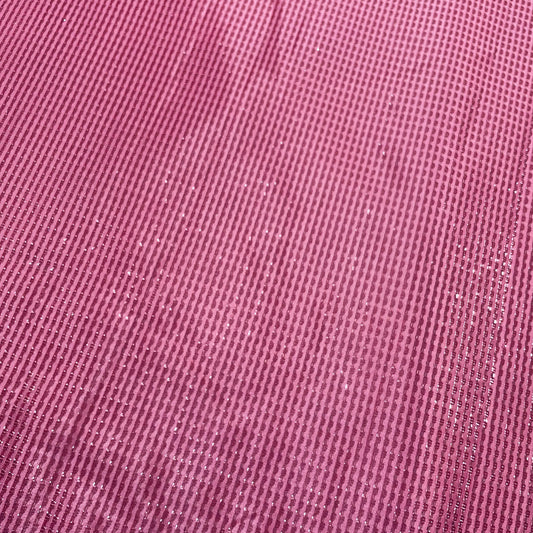Introduction About Best Knit Fabric
Knit fabrics comprise interlocking loops of yarn, forming a flexible, stretchy material perfect for clothing and upholstery that moulds against the body and furnishings.
The knitting process crafts the loops using needles or machines, with options spanning handmade to mass-produced. Knits drape and conform more fluidly than stiff woven textiles.
This comfort-centric versatility also accommodates high-performance demands through technical synthetic blends engineered for moisture-wicking, compression, cooling and odour resistance. Knit fabric constitutes anything from a cashmere sweater to a racing swimsuit.
Types of Knit Fabrics
Various knitting methods produce different fabric types:
- Single Knit: The basic knit stitch forming a flat smooth face reveals purled knobs on the reverse, often seen in t-shirts.
- Double Knit: Two layers, knitted in tandem, joined, like the jersey's smooth external with an internal terry surface.
- Jersey - Soft, stretchy single knit fabric for t-shirts and casual wear.
- Purl - Knit fabric with horizontal ridges on one side and recessed rows on the reverse. Adds textural interest.
- Fleece - Soft, insulating, breathable fabric with a napped pile surface. Perfect for sweatshirts.
- Cable Knit - Distinctive knit with twisted, rope-like strands creating a woven-looking texture. Iconic in sweaters.
- Rib Knit: Alternating knit and purl stitches make stretchy ribbing ideal for cuffs, collars and trim.
- Interlock Knit: Interconnected alternating front and back knit stitches create durable opacity perfect for stable high-performance athleticwear.

Cosy Creations: Knit Fabrics in Sweaters
Knit fabrics form the cosy, comforting foundation of our favourite sweaters. Unlike rigid woven fabrics, knits are created by interlocking a continuous length of yarn into rows of intermeshed loops.
The inherent stretch and soft drape of knitted fabrics gracefully conform to the body, warmly enveloping the wearer. Explore the creations possible with these textiles.
- Cable Knits: Intricately crossing and twisting multiple yarn strands forms embossed relief patterns with heritage warmth.
- Chunky Knits: Using deliberately oversized yarns and needles generates thick, insulating textures.
- Styling Tips: Knits lend themselves to casual layering, easily dressed up with collared shirts peeking out from underneath or downtown with jeans and sneakers for weekends.

Performance Prowess: Knit Fabrics in Activewear
In activewear, knit fabrics reveal their performance prowess. The stretchy construction and breathable structure of knits allow freedom of movement while wicking away sweat. Technical innovations like elastane blends and moisture management treatments maximise the capabilities of active knits. Beyond classic jerseys, structural designs like ribbing provide targeted support. Discover how knits empower performance.
- Elastane integrated knits like Lycra lend four-way stretch, permitting unencumbered mobility across every plane of motion.
- Technical knits rapidly wick sweat away from the skin toward quick-drying outer surfaces, keeping athletes comfortable and focused.
- Athletic brands stylistically leverage prints, textures, and compression in knits, fusing aesthetic appeal and assisting human physiology.

Sustainable Threads: Knit Fabrics and Eco-Friendly Fashion
Knit fabrics intertwine sustainability and style. Eco-friendly knits reduce textile waste and are made from organic fibres like bamboo, recycled polymers, and upcycled yarns.
Undyed, naturally-pigmented knits skip toxic dyeing. Low-impact finishing creates ultra-soft biodegradable fabrics. Ethical production supports local communities. Together, knits and sustainability weave responsibly crafted fashions with lower environmental impact.
- Eco-friendly Brands Setting the Benchmark: In athletic wear and essential clothing, some companies are starting to make their products more environmentally friendly by incorporating sustainability into their values. Their innovative use of recycled and organic materials to produce high-performance knits is impressive. It's great to see them lead the way in sustainable fashion.
- Guidelines for Mindful Consumption and Disposal of Knit Garments: Go for high-quality knits meant to last instead of buying the short-term trendy clothing that fast fashion businesses are known for. Donating or upcycling knit garments is a great way to dispose of them creatively. On the other hand, we can pick knitted items made from organic compost natural materials that are environmentally friendly.
Conclusion
Knit fabrics constitute a versatile textile family spanning cosy handmade sweaters to state-of-the-art athletic jerseys. Their formfitting comfort empowers knits across casual everyday wardrobes to high-performance sports engineering.
Yet sustainability should stay top of mind - higher quality knits last longer, and eco-friendly materials like organic cotton or recycled synthetics reduce waste. With options suiting every lifestyle and climate, explore knitting's possibilities, from learning a heritage stitch to making mindful purchases supporting ethical production.
The opportunities prove endless when embracing all knit fabrics can accomplish. Check out TradeUNO, a platform that offers a unique opportunity to explore, learn, and create. With TradeUNO, you can transform simple threads into intricate designs, making your fashion statement.
 Call Us
Call Us


















